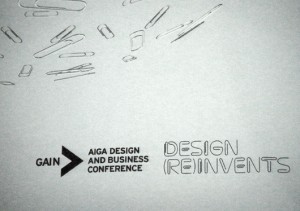There are a number of very good workshops and conferences in our industry and we try to be pretty selective in those we choose to attend. These gatherings are great for gaining practical knowledge and for recharging the creative batteries. Judging from past experience, AIGA always has very high quality programs and 2010 is an “on” year for GAIN, the organization’s biennial Design and Business Conference. Looking at the timely theme, Design (Re)Invents, and the impressive collection of topics and speakers, it was an easy choice. Kevin, my husband and agency partner, and I signed up for the October event.
 The conference promised “insights into positive, productive change, offering clues to help us on our own paths to reinvention,” as stated by Richard Grefé, AIGA executive director. Boy, did they deliver. The inspiration, creativity and energy of the case studies presented was remarkable.
The conference promised “insights into positive, productive change, offering clues to help us on our own paths to reinvention,” as stated by Richard Grefé, AIGA executive director. Boy, did they deliver. The inspiration, creativity and energy of the case studies presented was remarkable.
One of the examples that made perhaps the deepest impression on me, though, is the story of the High Line. After hearing the first-hand account of this reinvention story from Friends of the High Line cofounder Robert Hammond, we were able to actually experience this new public park — a living case-in-point of the potential that lies in imagining what can be. It’s the result of the vision and hard work that went into preserving and renovating an abandoned, decaying elevated railroad structure on the West Side of Manhattan.
The High Line was built in the 1930s to elevate freight trains serving the industrial plants, factories and warehouses of the Meatpacking District, West Chelsea and Clinton/Hell’s Kitchen. Shut down in 1980, the tracks were neglected for several years as different groups debated demolition versus preservation. Hammond cofounded his nonprofit organization in 1999 and the first phase of the High Line park opened 10 years later.
It’s a beautiful public space that incorporates dozens of subtle nods to its railroad history through its thoughtful design. There are spots for quiet reflection, as well as observing the activity of busy city streets and the Hudson River piers. Rotating art installations present works that relate to the High Line environment in some way. One of my favorites was the installation, A Bell for Every Minute. Sound artist Stephen Vitiello recorded bells all over New York City, some distinct and recognizable, others nondescript but linked to a real place. One of the recorded bells chimes every minute in the art space and a legend identifies the source of each particular bell.
Our afternoon on the High Line was one of the highlights of our trip and really illustrated the possibilities that present themselves when creative thinking is applied to a challenge. It also brought to mind the potential of a local green space project here in Lafayette. Very different, but not without similarity, the Save the Horse Farm initiative aims to preserve a tract of farmland in the middle of the city and turn it into a passive park. The idea is to maintain this small oasis for public use, rather than simply build more commercial development.
In addition to the High Line, there are several other recent park/green space projects to reference as models and more are in the works. One that also has caught my attention lately is the CityArchRiver project in St. Louis that intends to “create an iconic setting” for the Gateway Arch, “honoring its immediate surroundings and weaving connections and transitions from the city and the Arch grounds to the Mississippi River….” Natural, seamless integration with the existing landscape seems to be a key success factor in these efforts.
Innovation is a popular word right now and usually evokes images of technology, commerce and sometimes drastic change. But, in the case of the Horse Farm, the innovative approach may be the one that uses a light touch, focusing primarily on enhancements for citizen access and enjoyment of the property. Our rich local culture and the history of the property itself would provide an immense source of inspiration for the creation of such a park. Just as the High Line reflects its unique heritage, through its design, plantings and use, so could the Horse Farm Park.
These types of details will surely spur lots of healthy discussion before a final plan is determined. But after experiencing the High Line, it’s easy to see the value in reinventing our concept of how public spaces help shape our communities and our lives.

